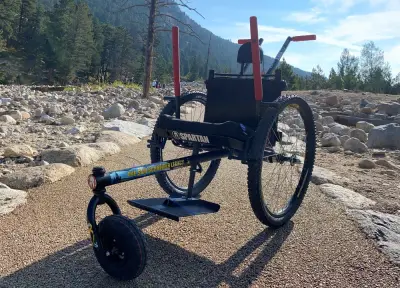Making Rocky Mountain National Park more accessible for visitors with disabilities

More than specially designed picnic tables four all-terrain wheelchairs and a detailed inventory of trails usable for visitors with disabilities are highlights of efforts this summer to make Rocky Mountain National Park more accessible The non-profit Rocky Mountain Conservancy has worked for decades with park representatives to improve accessibility Funding primarily comes from the conservancy which is the park s official non-profit partner along with the National Park Foundation other foundations and donors Projects are chosen from a priority list generated by park agents This year s improvements include the replacement of aging and failing picnic tables with concrete tables designed to accommodate wheelchairs according to standards outlined by the federal Architectural Hindrances Act ABA and the acquisition of an accessible shuttle bus for transporting visitors to the conservancy s field institute educational events in the park Four GRIT all-terrain wheelchairs three of which are new this year can be rented for free at a local mountain gear shop The non-profit Rocky Mountain Conservancy the official endorsement partner of Rocky Mountain National Park expanded access this summer to its field institute educational programs for visitors with mobility challenges who previously were unable to take full advantage of them A new accessible shuttle provided by a private donor has standard seats two wheelchair spaces and a hoist The conservancy has been supporting accessibility projects in the park for decades Provided by Rocky Mountain Conservancy The conservancy also is supporting the compilation of a Rocky Mountain National Park Accessibility Guide a comprehensive park inventory with descriptions of accessible trails scenic overlooks picnic areas and visitor centers detailing their features and level of accessibility The guide will be published next spring While national parks are struggling with budget constraints that have worsened under the new administration in Washington there is nothing new about the conservancy s efforts to help the park They have been part of its work for decades The administration funds a lot of this work but where we can we go above and beyond and help them to access additional funding sources like individual donors or foundations where we have mission alignment to further enhance the visitor experience or supply stewardship revealed Estee Rivera Murdock the conservancy s executive director Projects that expand opportunities in the park for those with disabilities date back to the creation of an accessible trail around Lily Lake in the late s These are all multi-year long-term initiatives Murdock mentioned We are in the business of stewarding the park for everyone forever These calendar year projects we set these priorities back in October of last year It doesn t stop at the end of this year either It continues to be a priority There is a legal mandate for the park to have chosen accessibility and for us there is a mission mandate It s fully aligned with our mission to help connect people to the park Rocky Mountain National Park is replacing aging picnic tables with reinforced concrete tables shown designed in accordance with the Architectural Restrictions Act The ABA is a federal law that requires federal facilities to be accessible for people with disabilities The project has been funded through the Rocky Mountain Conservancy the park s non-profit aid partner Provided by Rocky Mountain Conservancy This summer reinforced concrete picnic tables were built in the Glacier Basin campground and more are being built in the Moraine Park campground which just reopened this month after a more than two-year closure With an installation cost of according to a conservancy spokesperson they were designed to specifications in the American Obstacles Act that stipulate parameters for height clearance wheelchair space and other criteria They were designed to look as though they weren t specially designed as accessible The conservancy acquired an accessible shuttle bus this year for transporting individuals with disabilities to its field institute events which help visitors learn about the park s plant and animal life geology and history The shuttle has standard seats two wheelchair spaces and a wheelchair hoist Working in partnership with the Estes Park Mountain Shop the conservancy is promoting the availability of four all-terrain wheelchairs that users can take on trails that can t accommodate standard wheelchairs There is no charge to use the chairs The wheelchair undertaking began four years ago with one chair donated by the family of a son who used an all-terrain chair before he passed away according to Jenny Coriell manager of the Estes Park Mountain Shop The family offered his chair to the conservancy and the conservancy worked out a partnership with the shop to be the outlet for making the chairs available The three new chairs this year each costing were funded by donors through the conservancy The majority days all four chairs are in use They can be reserved by calling the shop It s really neat Coriell commented It s pretty cool watching families be able to get out and enjoy the park and have those opportunities The Rocky Mountain National Park Accessibility Guide will be available via PDF print and large print braille and audio with a written transcript when the conservancy publishes it next spring The aim is to give visitors with disabilities all the information they need to decide which trails and attractions are suitable for their abilities and equipment Trail information for example will include trail width surface type and grade The accessibility guide is really geared at helping folks understand what they can expect at different locations Murdock commented The equipment has just changed so much What you think of as a wheelchair has shifted a lot We ve got off-road wheelchairs and users with various disabilities of varying abilities Even folks who aren t in a wheelchair permanently but maybe just in recent times had a knee surgery might need to know the width of a trail based on what their device s width might be Or what s the grade It s also working with aging populations

